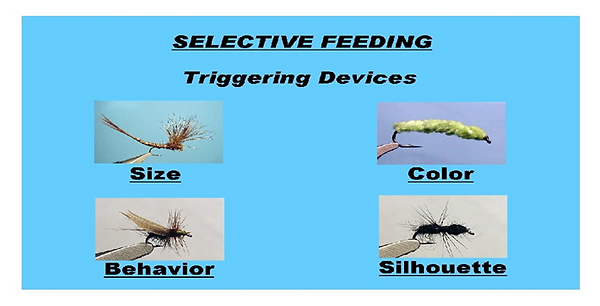Selective Feeding

Selective feeding is a phenomenon which occurs when fish are feeding heavily on a food organism because of its abundance. Examples are hatches of aquatic insects such as Mayflies, Stoneflies, Midge and Caddis, but selective feeding also occurs when fish eggs, minnows and other food items are in abundance, but, “…insects are still the major food source for the average trout.”*
This is a time when the fly fisher will out fish a bait or spin fisher. Understanding the mechanisms that trigger selective feeding is essential whether the fly fisher prefers to fish subsurface or on top.** (“Forty to seventy percent of predation occurs just prior to emergence.”*}
A fish is a victim of its own genetics. Although a wild trout’s IQ is very low it does have sharply honed genetic[A1] instincts. Selectivity is an entrained [A2] response.
Your mother told you about first impressions. Everything has something you notice first.
Look at a railroad engine; the first thing to pop into mind would be “BIG.” A cardinal at your bird feeder may bring COLOR to mind. Racecars say MOVEMENT. Compare an adult mayfly with an adult caddis; here the importance of silhouette is obvious.
A trout’s resolving power is about fourteen times worse than yours. While he might not be able to count the number of gills on a mayfly nymph, he definitely sees movement. Anyone that tells you trout are color blind doesn’t understand the cellular structure of a trout’s eye[A3] .
With insects like caddis, movement can be important and anyone who has tried to match a #24 tricorythodeswith a #22 trico pattern knows about selectivity as it relates to size.
Every fly has four triggering mechanisms: Size, Shape, Color and Behavior.
A fly must have a primary trigger, but secondary triggers must also be accurate.
REFUSALS
You see a trout rising in a tranquil pool. After tying a size 24 trico to your 8x tippet you present your imitation perfectly. The trout rises, just before taking the fly it veers off. Why?
The primary trigger brought him up, but as he approached the fly he saw a secondary trigger that wasn’t right.
I’ve heard anglers tell me the rattier their favorite fly gets the better it works. That’s because the superfluous stuff is gone leaving the primary trigger.
Be sure your imitation captures the insect’s primary trigger. If you can’t imitate the secondary triggers, skip them!
*Gary LaFontaine, Caddis flies. [best to use a standard footnote citation style, unless you are going to have a bibliography at the end. A standard style would be Gary LaFontaine, Caddis Flies (City: Name of Publisher, Date of publication), p. X. )
**Gary Borger, “Presentation.
[A1]Do we know that they are genetic? The sentence would lose nothing by just saying “sharply honed instincts”.
[A2]This is a new word for me. What does it mean?
[A3]So they have cones, as well as rods? Maybe say: “Trout have rods and cones, as humans do” (if true).